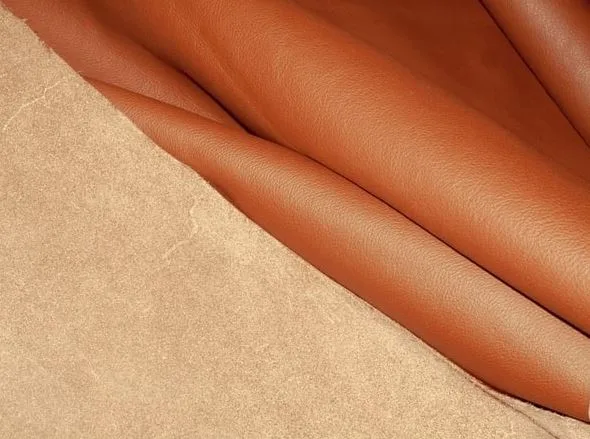Types of Leather Used in Manufacturing Export Quality Goods
Leather craftsmen know their material before making the first cut. Three leather types dominate export-quality manufacturing, each serving different market segments and price points.
Cowhide is the most durable and widely available type of leather. Goat leather offers superior flexibility with balanced strength for refined goods. Deerskin delivers premium softness and comfort, commanding the highest prices in luxury markets.
A reliable leather goods manufacturer works with all three types strategically. Each leather serves different purposes perfectly. The key lies in matching material properties to product requirements and the expectations of the target market.
Goat Leather vs Cowhide vs Deerskin Comparison
| Factos | Cowhide | Goatskin | Deerskin |
| Durability | 20-30+ years | 15-20 years | 10-25+ years |
| Comfort Level | Needs breaking in | Pretty comfortable | Feels perfect |
| Cost | Most affordable | 25% cheaper than cowhide | Expensive but worth it |
| Weight | Heavy | Lightweight | Ultra-light |
| Weather handling | Excellent when treated | Naturally water-resistant | Stays soft even when wet |
| Toughness rating | Maximum | Very high | Good |
Cowhide Leather Properties and Characteristics
Cowhide is the most famous leather type for its durability and affordable pricing. This leather type comes from cattle raised primarily for meat and dairy production. It creates an abundant supply and keeps costs competitive.
Why Cowhide Dominates the Global Leather Market
Cowhide comes from the same animals that give us steaks and milk. This means tons of supply, which keeps prices reasonable. But here’s the kicker – this “cheap” leather is actually incredibly tough.
The numbers that matter:
- Raw thickness: 6-10mm (gets split down to usable sizes)
- Finished products: Usually 1 to 3mm thick
- Durability proof: A 5,500 year old cowhide shoe was found in a cave.
Cowhide Advantages
- Exceptional durability that lasts for years with proper care
- Most affordable leather with high value for money
- Thick, protective material ideal for heavy-duty applications
- Develops attractive patina and character through aging
- Excellent resistance to punctures, tears, and abrasion
- Perfect for boxing gloves and heavy duty equipment
Cowhide Limitations and Drawbacks
- Heavy weight makes it uncomfortable for extended wear
- Requires a significant break-in period when new
- Thick, stiff texture unsuitable for delicate applications
- It can look basic compared to specialty leathers
- Shows water damage if not properly treated
- Limited flexibility and stretch compared to other leathers
Goatskin Leather Features and Performance
Goatskin offers military-grade performance in a lightweight package that many buyers overlook. The US Navy and Air Force chose goatskin for their aviator jackets because it provides great protection with less weight.
Military Applications and Strength Properties
- US Navy G-1 jackets = goatskin
- US Air Force A-2 jackets = goatskin
- Elite tactical gloves = goatskin
Goatskin Benefits
- Lightweight yet strong
- Flexible and comfortable from day one
- Unique pebbled grain texture provides natural grip
- Cost-effective option, typically 25% less than cowhide
- Natural water resistance without treatment
- Second most abrasion-resistant leather after kangaroo
- Excellent for gloves, lightweight jackets, and precision work
Goatskin Limitations and Considerations
- Smaller hide sizes limit options for large leather goods
- Less dramatic aging and patina development than cowhide
- Harder to source from suppliers compared to cowhide
- Not suitable for extremely heavy-duty applications
- A thinner profile may show wear faster in rough conditions
Deerskin Leather Quality and Premium Properties
Deerskin represents the luxury segment of the leather market, commanding premium prices for its unique characteristics. This leather stands apart because it actually becomes softer when wet instead of stiffening like most other leather types.
Why Deerskin Commands Premium Pricing
The uniqueness factor:
- Fiber structure is unlike any other leather
- Stays supple through wet/dry cycles
- Zero break-in time needed
- Natural oils keep it conditioned
Deerskin Premium Benefits and Advantages
- Exceptionally soft and comfortable with no break-in period required
- Remains soft even when wet, unlike other leather types
- Naturally breathable and comfortable in all weather conditions
- Unique fiber structure provides surprising durability despite softness
- Natural oils reduce maintenance requirements significantly
- Premium luxury feel recognized by leather enthusiasts
- Excellent for high-end footwear, gloves, and fashion accessories
- Ultra-lightweight yet maintains good protection
Deerskin Drawbacks and Cost Considerations
- Expensive pricing, often 2-3 times more than cowhide
- Limited supply makes sourcing difficult and inconsistent
- Not suitable for heavy or industrial applications
- Requires special knowledge for proper maintenance
- May show wear faster than thicker leathers in rough use
- Premium cost may not justify benefits for basic applications
Best Applications for Each Leather Type
Selecting the right leather requires matching material properties to specific performance requirements and intended use cases.
Choose Cowhide if:
- You work with your hands daily
- You ride motorcycles or do extreme sports
- You want something your kids can inherit
- Budget matters but quality can’t be compromised
- You like the classic tough leather look
Choose Goatskin if:
- You need flexibility without sacrificing strength
- Weight matters (long wear times)
- You want military-grade performance
- You prefer subtle quality over flashy luxury
- You need reliable grip and dexterity
Choose Deerskin if:
- Comfort is your top priority
- You appreciate subtle luxury
- You’re willing to pay for uniqueness
- You want something special that few people have
- Immediate comfort matters more than maximum durability
How Each Leather Ages Over Time?
Understanding how different leathers evolve through years of use helps buyers make informed long-term decisions. Each leather type develops distinctive aging characteristics that affect both appearance and performance over decades.
Cowhide Aging and Patina Development
Cowhide gradually softens during the first three years while developing an initial patina that adds character. Between years four and ten, rich color development occurs alongside distinctive wear patterns that create the classic leather appearance. After ten years of regular use, cowhide reaches maximum character with a vintage look that many consider the ideal leather aesthetic.
Goatskin Evolution and Character Development
Goatskin maintains its original appearance during the first five years with only subtle softening that enhances comfort. From years six through fifteen, the leather develops a refined patina while the natural grain pattern becomes more pronounced and attractive. After fifteen years, goatskin achieves a unique look without the dramatic changes seen in cowhide.
Deerskin Long-term Appearance Changes
Deerskin feels amazing from day one and stays that way for years. It barely changes how it looks during the first five years, which is perfect if you want that premium appearance to last. After about six years, it picks up some subtle character but never loses that soft feel. Even after fifteen years of regular use, deerskin still feels incredibly soft while looking beautifully aged.
Leather Pricing and Cost Analysis
Understanding the true cost of leather involves examining both upfront pricing and long-term value through years of use. Quality leather represents an investment that pays dividends through durability and performance over time.
| Leather Type | Entry Level | Premium Quality | Cost per Year (20 years) |
| Cowhide | $50-150 | $200-500 | $10-25 annually |
| Goatskin | $150-400 | $300-600 | $15-30 annually |
| Deerskin | $300-600 | $800-1500+ | $40-75 annually |
Leather Care and Maintenance Tips
Proper leather care extends product life while maintaining appearance and performance characteristics. Each leather type requires specific maintenance approaches based on its unique properties and typical use conditions.
Cowhide Care and Maintenance
- Clean monthly with light brushing to remove surface dirt and dust
- Apply deep conditioning every 3-6 months, depending on usage frequency
- Schedule professional assessment and waterproofing treatment annually
- Address stains immediately using appropriate leather cleaners
- Never use harsh chemicals that can damage the hide structure
Goatskin Maintenance Requirements
- Brush gently on a weekly basis to maintain the natural grain texture
- Apply light conditioning every six months, but avoid overconditioning
- Seek professional cleaning yearly only when necessary
- Remember that less maintenance is better for goatskin longevity
Deerskin Preservation Methods
- Clean as needed using a soft cloth and gentle wiping motions
- Condition minimally every 6 to 12 months to preserve natural oils
- Never use artificial heat for drying, as this causes permanent damage
- Trust that natural oils handle most maintenance requirements automatically
Environmental Impact and Sustainability Factors
Environmental considerations increasingly influence leather purchasing decisions as consumers become more conscious of sustainability. Understanding the environmental aspects of each leather type helps buyers make responsible choices that align with their values.
All three leather types benefit from being byproducts of existing meat and dairy industries, which reduces waste by utilizing materials that would otherwise require disposal. Local sourcing significantly reduces environmental impact through shorter transportation distances and better supply chain transparency. Responsible tanning practices minimize environmental harm through water recycling, waste reduction, and the elimination of harmful chemicals.
Conclusion
The best leather choice depends entirely on matching material properties to your specific requirements and intended use. Each leather type excels in different applications and serves different buyer priorities.
Cowhide represents the reliable workhorse option that delivers consistent performance for decades without compromise. Goatskin offers smart performance that exceeds expectations while remaining affordable for most applications. Deerskin provides the luxury experience that justifies premium pricing through unique characteristics unavailable elsewhere. The key lies in honestly assessing what you need the leather to accomplish rather than choosing based on prestige or assumptions.





